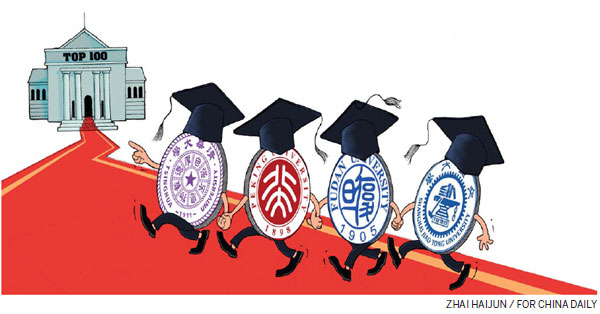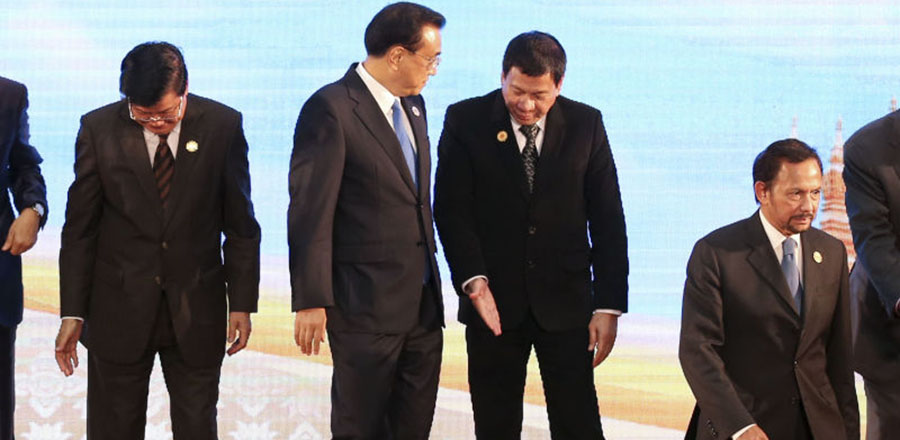
Survey concludes performance is a result of high levels of national investment and dedicated projects in universities
The release of the QS World University Rankings for the academic year 2016-17 - the 13th edition of the internationally respected indicator of higher education quality - presents good news for universities from emerging nations, and China in particular.
Four Chinese mainland universities are in the world's top 100, the positions often used as a key promotional message and mark of global credibility.

Three of these sit firmly in the top 50 with Beijing's Tsinghua University the highest ranked, rising from 25th last year to 24th this year. Peking University sits not far behind, in 39th place, up from 41st last year. Shanghai's Fudan University is also fast gaining ground, jumping inside the world's top 50 to 43rd, up from 51st only a year ago.
Overall, all bar one of China's elite C9 University group (analogous with the US Ivy League and the UK's Russell Group) improved their rankings: Tsinghua (up one place to its highest ever ranking of joint 24th), Peking University (up two places to 39th), Fudan University (eight places to 43rd), Shanghai Jiaotong (up nine places to 61st), University of Science and Technology of China (also up nine places to 104th), Nanjing University (up 15 places to 115), Harbin Institute of Technology (up 13 places to 278th) and Xi'an Jiaotong University (up 13 places to 318th).
Eight of the C9 also gained ground in the key indicator of "research impact", which examines just how beneficial a university's research output has proved to be across the wider community.

But perhaps most auspicious about the rankings this year is the geographical spread. While the top-placed Chinese universities reside in the first-tier cities of Beijing and Shanghai, it is extremely encouraging for the entire network of Chinese universities that respected representation can be found outside.
In particular, the University of Science and Technology of China, in Hefei, the capital of East China's Anhui province, can now proudly boast a ranking narrowly outside the top 100, up to 104th position this year from 113th last year.
Hot on the heels of Hefei, the aesthetically appealing city of Hangzhou houses one of the oldest and most prestigious universities across the Chinese mainland: Zhejiang University. Zhejiang also threatens to break into the top 100 very soon, currently hovering at 110.
Across the wider Asian region, there is also much to marvel at, with front-runners National University of Singapore and fellow Singaporean institution Nanyang Technological University cementing themselves at 12th and 13th respectively.
But what lies behind this recent surge in Asian, and in particular Chinese mainland, rankings?
The QS survey authors conclude that this is not just a recent, unexpected phenomenon but rather the result of sustained, high levels of national investment and dedicated projects. The Chinese government has been well ahead of the competition for some time with the key 211 and 985 projects coming to fruition now.
Project 211, in particular, has surely proved a key contributory factor here. Initiated as far back as 1995 by the Ministry of Education, the focus of this project was on raising all aspects of academic research standards at the highest-level universities. Project 211 targeted only the very top of the mainland university league table, and even today only around 6 percent of China's 116 universities come under the Project 211 umbrella.
Such a focus on only the elite universities appears to have paid dividends.

Furthermore, Project 211 was not simply empty promotional jargon in an attempt to showcase development of China's university sector. Instead, specific, quantified targets remain in place. For example, Project 211 participants have to implement advanced research methods and training programs for 80 percent of their PhD students.
Project 985, started in 1998, continued an investment intensity across China's university network while also maintaining a "brightest and best" selection system. This led in 2009 to the creation of China's most elite group of nine universities, often simply referred to as the C9.
Of course, to understand why China and other emerging nations are experiencing continued development, it is necessary to closely consider the QS survey methodology.
The survey applies six performance indicators, and for each of these indicators a ranking is calculated across the four areas of research, teaching, employability and internationalization.
Academic reputation is by far the most important of the six performance indicators, accounting for a 40 percent weighting toward the overall score.
Here, a global survey is used, targeting academics all over the world, who are asked a series of questions to find out where they believe the best work is currently taking place in their field of expertise. Chinese universities are increasingly prevalent internationally, partnering Western academics in research and teaching collaboration, which has probably contributed considerably to higher scores in this performance category.
Employer reputation, although a performance indicator accounting for only a 10 percent weighting, is also an area where Chinese mainland universities have scored higher in recent years. This performance indicator also makes use of a global survey in which employers are asked to state which universities around the world they believe are producing the best students.
Increasing numbers of graduates from mainland universities are now competing fiercely with graduates from leading Western universities. Western blue chips now recognize that continued success across attractive Asian markets requires well-trained Chinese university students and also acknowledge the first-class education on offer at China's top higher-education institutions.
But perhaps the single most influential performance indicator is the citations per faculty indicators, responsible for a 20 percent weighting to a university's overall ranking score.
This is not only the one area where academic credibility can be measured most easily, it is also the area where in the past mainland universities have struggled to compete.
The number of times an academic's research has been cited as well as the sources, such as distinguished, peer-reviewed international academic journals, represent a key measure of success.
This is also an area where mainland academics have excelled recently, partly as a result of projects 211 and 985.
Finally two further performance indicators: international faculty ratio (5 percent weighting) and international student ratio (5 percent weighting) are also areas where mainland universities are getting stronger.
Prospective Western university students now acknowledge that any international business or related career requires at least part of their education to be completed at a leading Asian, especially Chinese, university. Such is the increasing global importance of markets and companies in this region.
All in all, the mainland university sector is set to rise and, with this, equip the new generation of students with the knowledge and skills to succed internationally.
European industries across all sectors, keen to penetrate and maintain attractive positions in increasingly important Asian markets, should sit up and direct considerable university recruitment funds and activities at mainland universities.
European Universities should also seek more teaching and research cooperation and collaboration with China's top universities, from which they can now learn more.
The author is a visiting professor at the University of International Business and Economics in Beijing and a senior lecturer at Southampton University. The views do not necessarily reflect those of China Daily.
(China Daily Africa Weekly 09/09/2016 page12)








